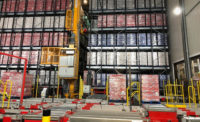Using Warehouse Automation to Support and Enhance Food Safety
Three things manufacturers and distributors should consider to manage product safety and quality in refrigerated and frozen environments.

Swisslog’s entire portfolio of automation solutions and software is available in the Canadian market, with special focus on general merchandise, food and beverage, industrial manufacturing, electronics and healthcare industries. Image courtesy of Swisslog
Automation has tremendous benefits across the whole food and beverage supply chain. Automated storage and retrieval systems (ASRS), for example, help manufacturers and distributors of chilled and frozen products increase storage capacity without expanding the physical footprint of their facilities, better manage SKU growth and increased throughput. Downstream, in areas like retail fulfilment, mixed-case palletizing systems are automating one of the most time-consuming and physically demanding jobs in distribution. In frozen warehouses, automation also enables energy saving facility designs and minimizes exposure of warehouse personnel to harsh environments.
There is another benefit of automation that should be considered in chilled and frozen environments: its ability to support and enhance safety and quality control measures. This column reviews three automation considerations that can directly impact the ability of manufacturers and distributors to manage product safety and quality in refrigerated and frozen environments.
Designing in Safety
Taking a holistic approach to an automation solution design can enable safer, more efficient management of temperature-controlled products not only within storage but as they move from production through distribution.
A leading cold chain 3PL, for example, was contracted by one of the world’s largest food companies to develop a new distribution center to support expansion of an ice cream production facility. A key feature of the new distribution center was an automated pallet ASRS to reduce manual handling of products within the facility and increase storage capacity. However, the distribution center had to be located on the other side of the road from the production facility, creating transportation and chain-of-custody challenges between the two facilities.
These challenges were addressed by expanding the scope of the solution design to encompass transportation from production to distribution. A temperature-controlled corridor was constructed 25 feet above ground to enable automated pallet movement across the road that eliminates handling, enables tracking, and is unobstructed by facility truck traffic. Pallets from production are loaded onto automated guided vehicles (AGVs) by conveyor and travel across the raised corridor to the distribution center where they are picked by the ASRS.
The same software that controls the automation system controls the entire process. This software interfaces with the 3PLs’ WMS and the production system at the ice cream facility, enabling tracking throughout the process. When a pallet is delivered to the in-feed of the elevated corridor, the software scans it, records receipt and provides comprehensive tracking and traceability as products move through the warehouse.
Automation Control Software and Food Safety
The example above also highlights the important role warehouse control software (WCS) and warehouse execution software (WES) can play in supporting cold chain compliance.
The WCS manages inventory within the automation system to maintain quality and enable traceability. It supports first-expiry-first-out (FEFO) and first-in-first-out (FIFO) inventory management strategies through automated stock rotation and slot allocation and also provides tracking of products by batch to support recalls, if needed.
The software continuously monitors temperatures across different zones of the cold storage to ensure products are stored in the proper temperature range and can monitor how long products are exposed to temperatures outside the desired range and send alerts based on user-defined time limits. For example, if loading is delayed and a pallet of frozen products is sitting on the dock for too long, the software will send an alert to return the pallet to storage, helping to prevent spoilage.
Detailed logs and audit trails are maintained for all temperature readings, stock movements, and user actions to simplify compliance reporting and provide reports for use in audits.
When operating as part of a modular, integrated WES platform, the WCS contributes to centralized traceability and reporting across multiple systems and processes. A WES can also provide real-time 3D visualizations of warehouse processes, creating a “digital shadow” that gives operators complete visibility into inventory location and status. This can be particularly valuable in frozen warehouses as it eliminates the need for the operator to enter the temperature-controlled environment to see if a pallet or carton is assigned to an order, waiting to be picked, or available.
Uptime and Product Safety
Extended downtime in an automation system can leave products trapped in storage, eroding customer relationships and jeopardizing quality. That’s why the final consideration is reliability and service.
Automation availability starts with system reliability. Frozen and chilled environments place different demands on automation systems than in ambient conditions. Automation systems used in chilled or frozen environments should use cold-resistant materials and lubricants to prevent brittleness, cracking, or seizing at low temperatures. Heated control cabinets with easy service access are also generally recommended.
Different automation technologies may have different requirements in terms of hardening the system for operation in frozen environments, so make sure the systems you are planning to deploy have been proven reliable in the environment you plan to deploy in.
The other component of availability is the ability to recover quickly if issues do occur. The choice of a WES platform that can support multiple automation systems and subsystems through a “single point of control” delivers real value in speed of recovery. In a system that lacks single-point control, recovery may require the operator to clear the error in multiple places, increasing downtime. With single point of control, when the error is cleared once, it is automatically communicated to all other relevant systems and processes can be restarted immediately.
Of course, you also want to ensure your automation partner has robust hardware and software services capable of responding quickly to issues that can’t be resolved by in-house resources.
Better Visibility, More Control
There are a number of warehouse automation technologies available for chilled and frozen environments today, which allows the technology to be precisely matched to the application.
To identify the appropriate automation for an application, work with a vendor that supports a broad range of warehouse technologies and has demonstrated a technology-agnostic approach to technology selection in their previous projects. In a technology-agnostic approach, application, product and order data dictate system selection.
In addition, there are established best practices for design, configuration and deployment of automation in chilled and refrigerated environments. When followed they help streamline deployment, improve availability and ensure automation can adapt to future changes in requirements.
Manufacturers and distributors of frozen and chilled products need to prioritize safety in every stage of their automation process, from initial design to ongoing lifecycle support. With the right solution, they can address capacity, throughput and inventory management challenges while enabling the visibility and control they need to effectively manage safety and quality.
Looking for a reprint of this article?
From high-res PDFs to custom plaques, order your copy today!







